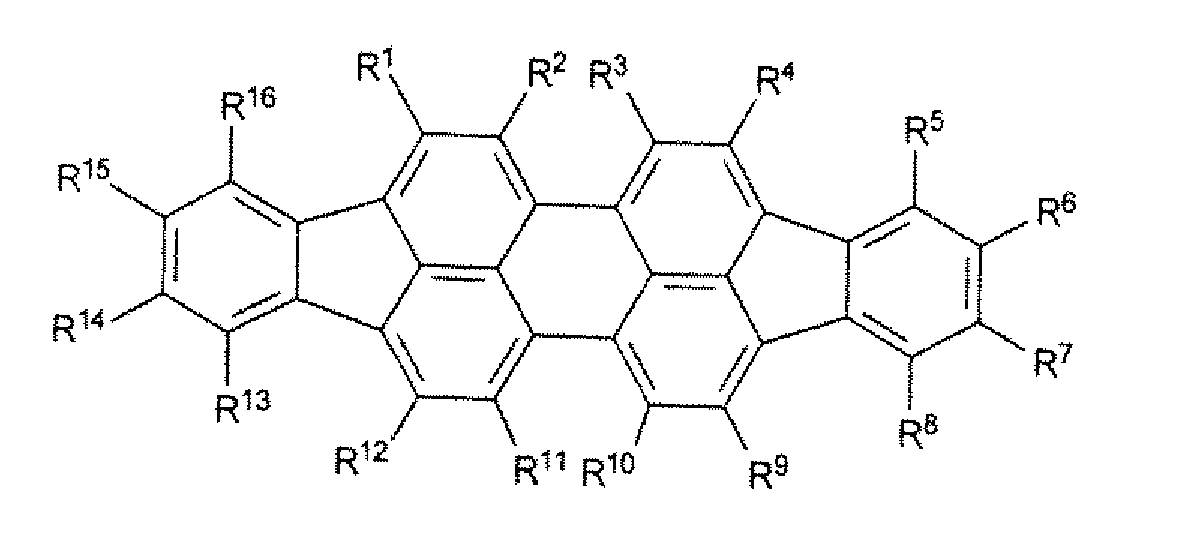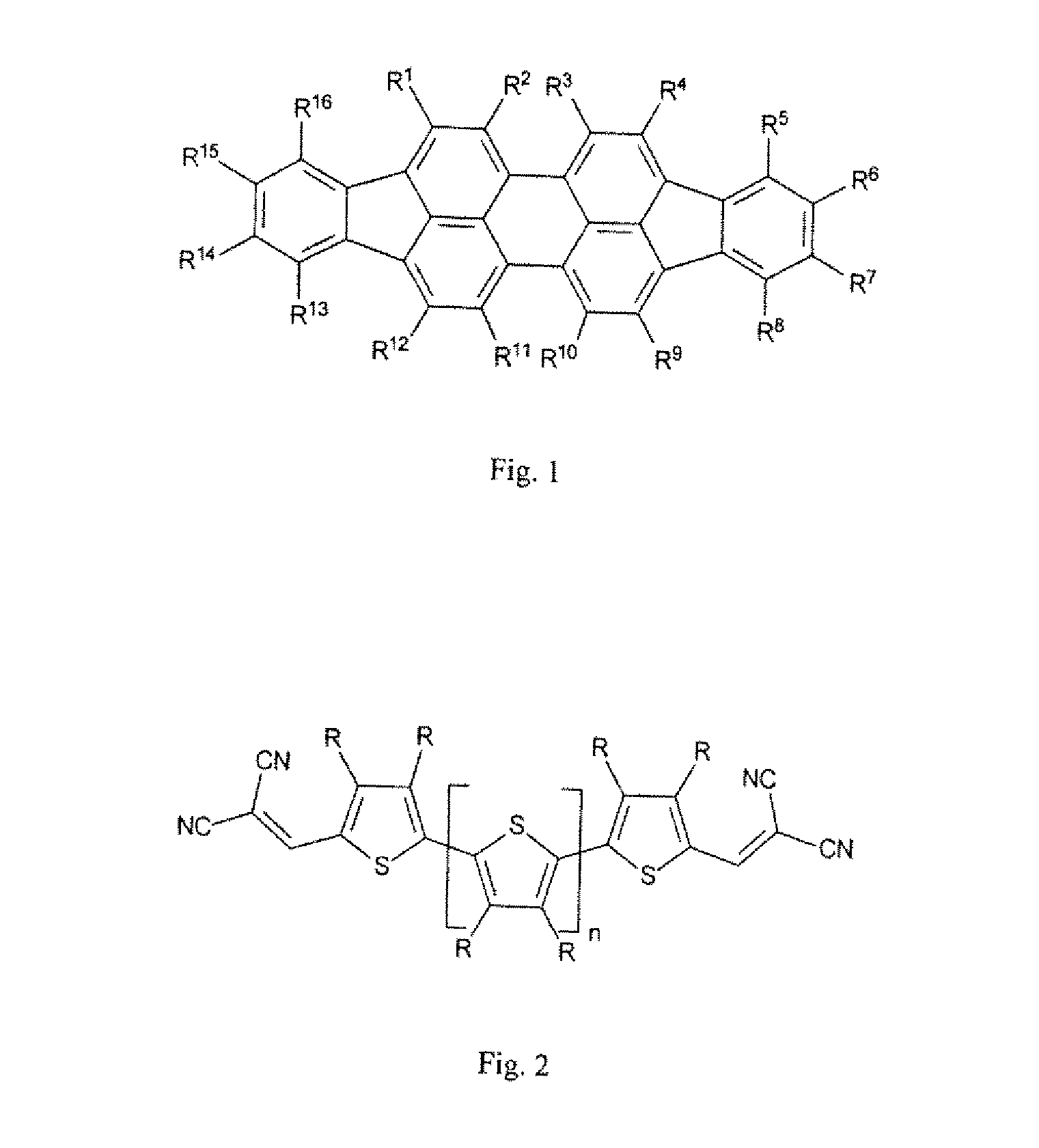Organic Solar Cell or Photodetector Having Improved Absorption
a solar cell and solar energy technology, applied in the field of photoactive components, can solve the problems of inability to use monocrystalline organic materials, inability to produce multiple layers with sufficient structural perfection, and inability to separate excitons by very powerful electric fields or at suitable interfaces, etc., to achieve the effect of increasing the focus of the industry
- Summary
- Abstract
- Description
- Claims
- Application Information
AI Technical Summary
Benefits of technology
Problems solved by technology
Method used
Image
Examples
synthesis example 1
[0076]8,9-dibutyl-7,10-diphenyl fluoranthene: 3.56 g acecyclone (10 mmol), the same amount of 5-decin and 20 mL xylene were heated for 16 h in a sealed ampoule to 250° C. After all the volatile components had been removed by distillation, the residue was extracted from a layer of silica gel K60 with pentane. 2.91 g (6.24 mmol, 62% of theory) of a slightly yellowish solid were obtained. C36H34 Mw=466.66 g / mol. Elemental analysis: C, 92.22%; (adj. 92.66%), H, 7.42%; (adj. 7.34%).
[0077]ESI-MS (0.5 mM NH4COOH, +10 V): 467.3 (100) [M+H+], 950.6 (80) [2M+NH4+]. 1H-NMR (500 MHz, CDCl3): 7.61 (d, 3J=7.8 Hz, 1H), 7.60-7.52 (m, 3H), 7.48-7.46 (m, 2H), 6.26 (d, 33-6.8 Hz, 1H), 2.55 (t, 3J=8.4 Hz, 2H), 1.47 (quin., 3J=7.3 Hz, 3J=8.4 Hz, 2H), 1.21 (sex., 33-7.4 Hz, 3J=7.3 Hz, 2H), 0.77 (t, 3J=7.4 Hz, 3H). 13C-NMR (125 MHz, CDCl3): 140.7, 138.8, 137.9, 137.0, 135.2, 132.8, 129.4, 128.8, 127.5, 127.3, 125.8, 122.4, 33.6. 29.8, 23.2. 13.6.
synthesis example 2
[0078]2,3,10,11-tertabutyl-1,4,9,12-tetraphenyl-di-indeno[cd:lm]perylene; 3.8 g iron(III) chloride in 6 mL nitromethane were added drop-wise to a deoxygenated solution of 0.933 g 8,9-dibutyl-7,10-diphenyl fluoranthene in 40 mL dichloromethane and then stirred for 5 min. Nitrogen was introduced constantly throughout. After the addition of 60 mL methanol, the mixture was filtered, and the solid was washed with methanol until the wash solution was colourless. The product was obtained in an amount of 0.867 g (1.87 mmol, 92% of theory) as a purple powder. C36H34 Mw=926.30 g / mol. Elemental analysis: C, 92.18%; (adj. 93.06%), H, 6.95%; (adj. 6.94%).
[0079]ESI-MS (0.5 mM NH4COOH, +10 V): 929.5 (100) [M+H+], 872.5 (23) [M+H+−C4H9]. 1H-NMR (500 MHz, CDCl3): 7.66 (d, 3J=7.7 Hz, 1H), 7.57-7.51 (m, 3H), 7.44-7.43 (m, 2H), 6.14 (d, 33-7.7 Hz, 1H), 2.49 (t, 3J=8.4 Hz, 2H), 1.45 (quin., 3J=8.4 Hz, 3J=7.6 Hz, 2H), 1.18 (sex., 3J=7.6 Hz, 3J=7.3 Hz, 2H), 0.74 (t, 3J=7.3 Hz, 3H). 13C-NMR (125 MHz, CDCl3...
worked embodiment 1
[0080](The figures in the text refer to Illustration 11)
[0081]Documentation of an organic solar cell with a di-indenoperylene derivative (more precisely: dibenzoperiflanthene as a preferred example) as the absorber material using p-doped charge carrier transport layers. The objective here was to obtain a combination of a high photoelectric current and high photovoltage.
[0082]A sample was produced on glass (0), with a transparent earthing electrode of tin-doped indium oxide (ITO, 1), with a 1-nm-thick layer of a p-dopant or acceptor material, such as NDP9 (Novafed AG) (2), followed by a 25-nm-thick layer of N,N′-diphenyl-N,N′-bis(4′-(N,N-bis(naphth-1-yl)-amino)-biphenyl-4-yl)-benzidine (Di-NPD), p-doped with 5% of a p-dopant, such as NDP9, (3). The light-absorbing layers were applied on top: 6 nm dibenzoperiflanthene (4), 30 nm mixture of dibenzoperiflanthene with C60 (mixing ratio 2:3) (5), 35 nm C60 (6), followed by an exciton-blocker layer of 6 nm 4,7-diphenyl-1,10-phenanthroline ...
PUM
| Property | Measurement | Unit |
|---|---|---|
| Fraction | aaaaa | aaaaa |
| Diameter | aaaaa | aaaaa |
| Transport properties | aaaaa | aaaaa |
Abstract
Description
Claims
Application Information
 Login to View More
Login to View More - R&D
- Intellectual Property
- Life Sciences
- Materials
- Tech Scout
- Unparalleled Data Quality
- Higher Quality Content
- 60% Fewer Hallucinations
Browse by: Latest US Patents, China's latest patents, Technical Efficacy Thesaurus, Application Domain, Technology Topic, Popular Technical Reports.
© 2025 PatSnap. All rights reserved.Legal|Privacy policy|Modern Slavery Act Transparency Statement|Sitemap|About US| Contact US: help@patsnap.com



